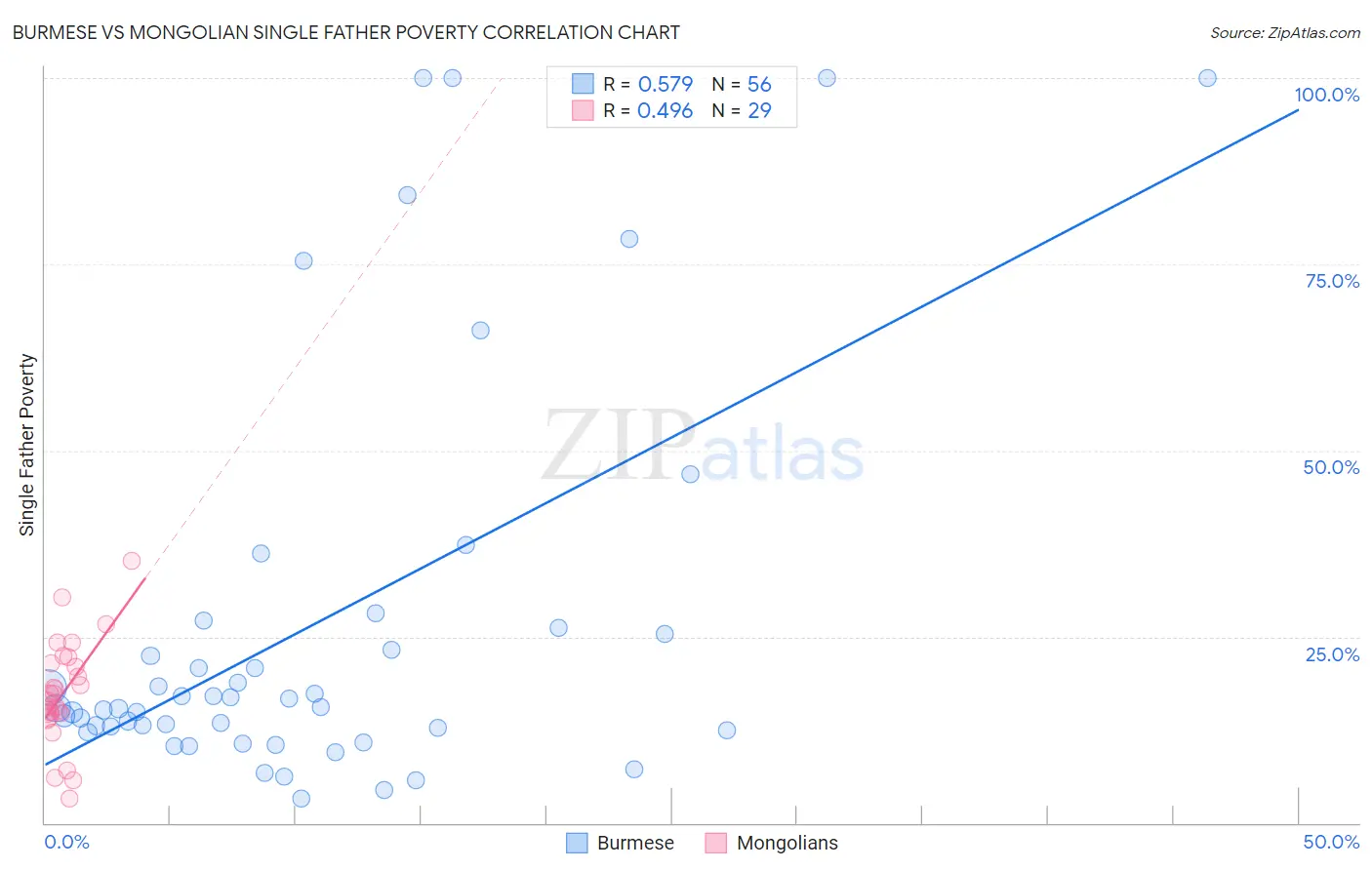Burmese vs Mongolian Single Father Poverty
COMPARE
Burmese
Mongolian
Single Father Poverty
Single Father Poverty Comparison
Burmese
Mongolians
15.5%
SINGLE FATHER POVERTY
99.0/ 100
METRIC RATING
88th/ 347
METRIC RANK
15.3%
SINGLE FATHER POVERTY
99.7/ 100
METRIC RATING
70th/ 347
METRIC RANK
Burmese vs Mongolian Single Father Poverty Correlation Chart
The statistical analysis conducted on geographies consisting of 355,001,827 people shows a substantial positive correlation between the proportion of Burmese and poverty level among single fathers in the United States with a correlation coefficient (R) of 0.579 and weighted average of 15.5%. Similarly, the statistical analysis conducted on geographies consisting of 122,619,201 people shows a moderate positive correlation between the proportion of Mongolians and poverty level among single fathers in the United States with a correlation coefficient (R) of 0.496 and weighted average of 15.3%, a difference of 1.4%.

Single Father Poverty Correlation Summary
| Measurement | Burmese | Mongolian |
| Minimum | 3.2% | 3.3% |
| Maximum | 100.0% | 35.2% |
| Range | 96.8% | 31.9% |
| Mean | 26.6% | 17.5% |
| Median | 15.4% | 17.4% |
| Interquartile 25% (IQ1) | 12.7% | 14.6% |
| Interquartile 75% (IQ3) | 25.9% | 21.8% |
| Interquartile Range (IQR) | 13.2% | 7.2% |
| Standard Deviation (Sample) | 26.9% | 7.1% |
| Standard Deviation (Population) | 26.7% | 6.9% |
Demographics Similar to Burmese and Mongolians by Single Father Poverty
In terms of single father poverty, the demographic groups most similar to Burmese are Brazilian (15.5%, a difference of 0.030%), Immigrants from Russia (15.5%, a difference of 0.040%), Immigrants from Korea (15.5%, a difference of 0.060%), Immigrants from Oceania (15.4%, a difference of 0.16%), and Peruvian (15.4%, a difference of 0.28%). Similarly, the demographic groups most similar to Mongolians are Japanese (15.2%, a difference of 0.10%), Immigrants from Brazil (15.3%, a difference of 0.21%), Immigrants from Lithuania (15.3%, a difference of 0.33%), Kenyan (15.3%, a difference of 0.42%), and Maltese (15.3%, a difference of 0.46%).
| Demographics | Rating | Rank | Single Father Poverty |
| Japanese | 99.7 /100 | #69 | Exceptional 15.2% |
| Mongolians | 99.7 /100 | #70 | Exceptional 15.3% |
| Immigrants | Brazil | 99.6 /100 | #71 | Exceptional 15.3% |
| Immigrants | Lithuania | 99.6 /100 | #72 | Exceptional 15.3% |
| Kenyans | 99.6 /100 | #73 | Exceptional 15.3% |
| Maltese | 99.6 /100 | #74 | Exceptional 15.3% |
| Immigrants | Turkey | 99.5 /100 | #75 | Exceptional 15.3% |
| Immigrants | Japan | 99.5 /100 | #76 | Exceptional 15.3% |
| Immigrants | Peru | 99.5 /100 | #77 | Exceptional 15.3% |
| Tlingit-Haida | 99.5 /100 | #78 | Exceptional 15.3% |
| Immigrants | Northern Africa | 99.5 /100 | #79 | Exceptional 15.3% |
| Armenians | 99.4 /100 | #80 | Exceptional 15.4% |
| Immigrants | Congo | 99.4 /100 | #81 | Exceptional 15.4% |
| Immigrants | Ukraine | 99.4 /100 | #82 | Exceptional 15.4% |
| Chinese | 99.3 /100 | #83 | Exceptional 15.4% |
| Peruvians | 99.2 /100 | #84 | Exceptional 15.4% |
| Immigrants | Oceania | 99.1 /100 | #85 | Exceptional 15.4% |
| Immigrants | Russia | 99.0 /100 | #86 | Exceptional 15.5% |
| Brazilians | 99.0 /100 | #87 | Exceptional 15.5% |
| Burmese | 99.0 /100 | #88 | Exceptional 15.5% |
| Immigrants | Korea | 99.0 /100 | #89 | Exceptional 15.5% |